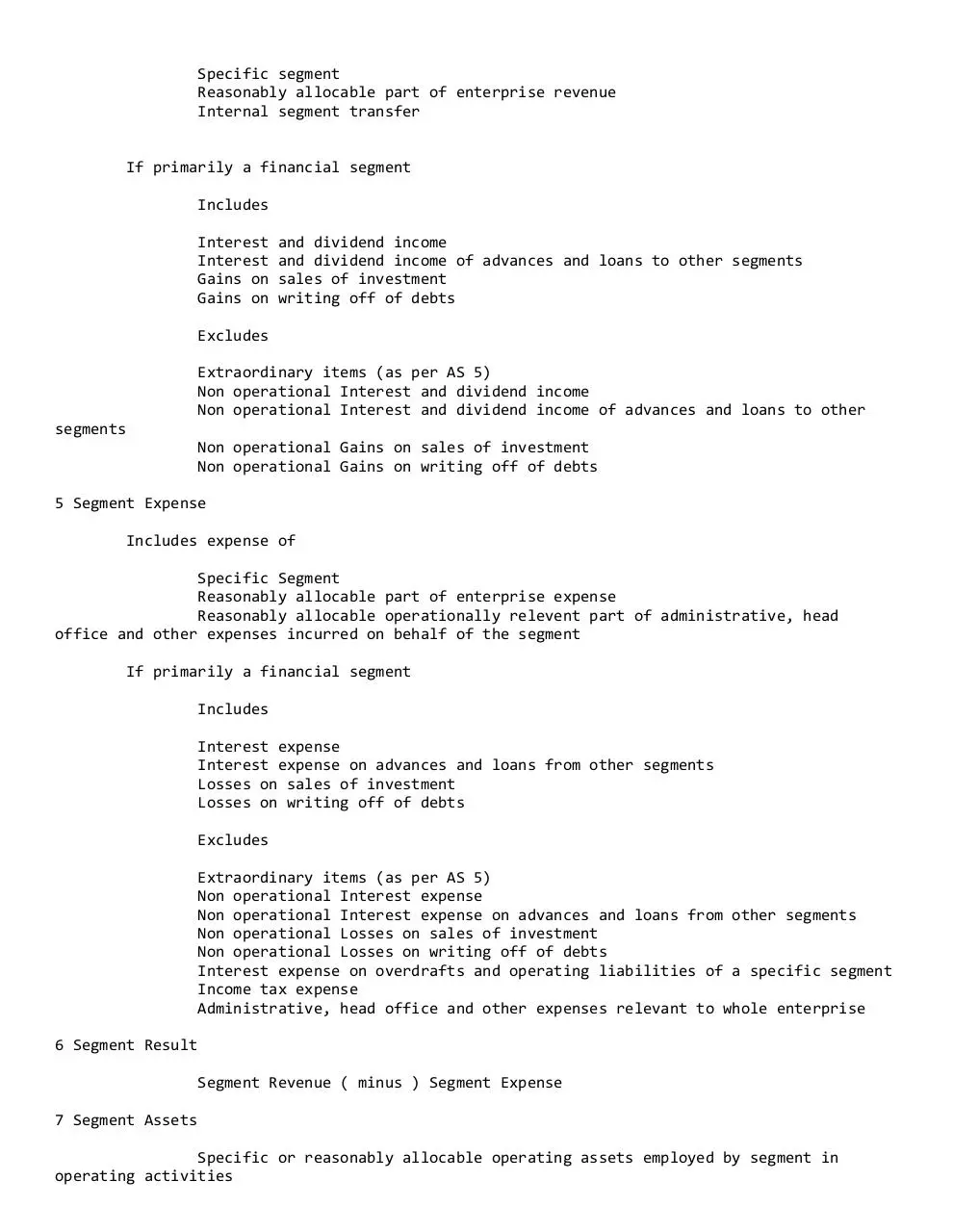AS 17 (PDF)
File information
This PDF 1.4 document has been generated by , and has been sent on pdf-archive.com on 05/12/2014 at 10:34, from IP address 117.206.x.x.
The current document download page has been viewed 520 times.
File size: 47.31 KB (4 pages).
Privacy: public file




File preview
AS 17 Segment Reporting
Why is it required ?
For a clearer understanding of the performances of segments.
Scope :
For
General Purpose Financial Statements or
Consolidated Financial Statements.
If Financial report contains both, then on the basis of CFS.
Nomenclature :
1 Business Segment
Distinguishable component of an enterprise, engaged in providing an individual product
or service or a group of related product or services
and
subject to risks and returns exclusive of other segments.
Factors to be considered for classifying related products and services
Nature of products and services
Nature of processing
Class of customers
Distribution system
Nature of domain (Banking,Insurance etc)
2 Geographical Segment
Distinguishable component of an enterprise, engaged in providing an individual product
or service or a group of related product or services within a specific environment
and
subject to risks and returns exclusive of other segments.
Factors to be considered in identifying Geographical Segment
Similarity of economic and political scene
Proximity
3 Enterprise Revenue
Sales revenue from external customers (excludes internal segment transfer)
4 Segment Revenue
Includes revenue of
Specific segment
Reasonably allocable part of enterprise revenue
Internal segment transfer
If primarily a financial segment
Includes
Interest and dividend income
Interest and dividend income of advances and loans to other segments
Gains on sales of investment
Gains on writing off of debts
Excludes
Extraordinary items (as per AS 5)
Non operational Interest and dividend income
Non operational Interest and dividend income of advances and loans to other
segments
Non operational Gains on sales of investment
Non operational Gains on writing off of debts
5 Segment Expense
Includes expense of
Specific Segment
Reasonably allocable part of enterprise expense
Reasonably allocable operationally relevent part of administrative, head
office and other expenses incurred on behalf of the segment
If primarily a financial segment
Includes
Interest expense
Interest expense on advances and loans from other segments
Losses on sales of investment
Losses on writing off of debts
Excludes
Extraordinary items (as per AS 5)
Non operational Interest expense
Non operational Interest expense on advances and loans from other segments
Non operational Losses on sales of investment
Non operational Losses on writing off of debts
Interest expense on overdrafts and operating liabilities of a specific segment
Income tax expense
Administrative, head office and other expenses relevant to whole enterprise
6 Segment Result
Segment Revenue ( minus ) Segment Expense
7 Segment Assets
Specific or reasonably allocable operating assets employed by segment in
operating activities
If segment result includes interest or dividend income then segment assets
include related receivables, loans, investments or other interest or dividend
generating assets
Income tax assets are excluded in any case
Relevant allowances and provisions are deducted before balance sheet reporting
8 Segment Liabilities
Specific or reasonably allocable operating liabilities of segment from
operating activities
If segment result includes interest expense then segment assets include
related interest‐bearing liabilities
Income tax liabilities are excluded in any case
9 Segment Accounting Policies
policies.
Accounting policies applicable to enterprise as well as specific segment
How to ascertain if a segment is reportable ?
Based on
a) Revenue
Revenue of segment (external customers + internal transfers) is
atleast 10% of all segments.
b) Profit or Loss
Segment result ( higher of (combined result of all segments in profits
or loss)) is atleast 10% of all segments.
c) Segment assets
Segment assets are atleast 10 % of all segments.
If the segment becomes reportable in any one of the above tests then
it becomes a reportable segment.
d) Preceeding data
If segment reportable in previous period, then reportable in current
period also.
e) Total External revenue
If external revenue of reportable segments less than 75% of total
enterprise revenue additional segments to be identified as reportable until 75% of
external revenue is included.
f) Management Choice
How to determine primary and secondary reporting formats ?
Dominant source
Reporting Format
Primary
Secondary
Differences in products
and services
Business
Geographic
Differences in Geographic
locations
Both
Geographic
Business
Geographic
Business
Neither
Depending risks and returns more relevant to the segment
Download AS 17
AS 17.pdf (PDF, 47.31 KB)
Download PDF
Share this file on social networks
Link to this page
Permanent link
Use the permanent link to the download page to share your document on Facebook, Twitter, LinkedIn, or directly with a contact by e-Mail, Messenger, Whatsapp, Line..
Short link
Use the short link to share your document on Twitter or by text message (SMS)
HTML Code
Copy the following HTML code to share your document on a Website or Blog
QR Code to this page

This file has been shared publicly by a user of PDF Archive.
Document ID: 0000197571.